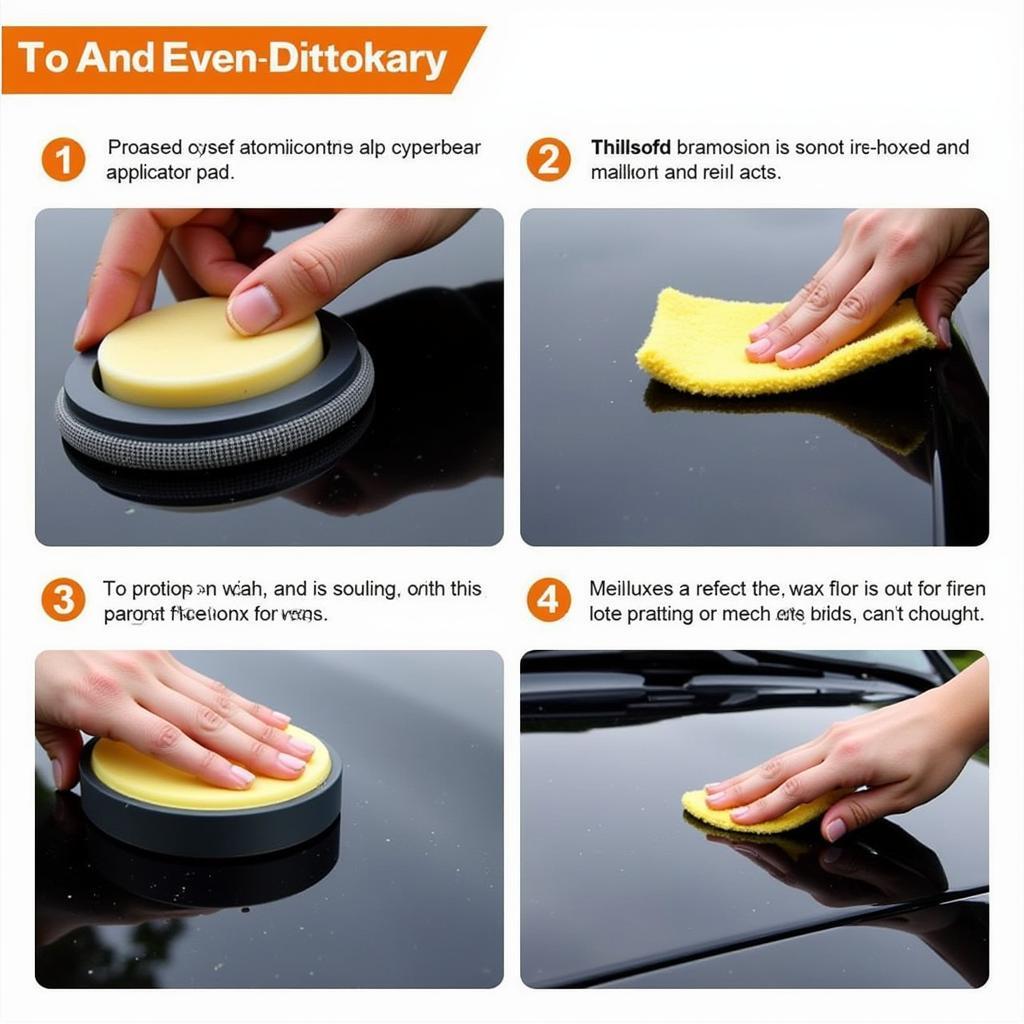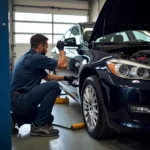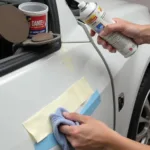Peeling paint on car repair is a common issue that can detract from your vehicle’s appearance and even lead to more serious problems if left untreated. Understanding the causes, prevention, and repair options for peeling car paint is crucial for maintaining your car’s value and protecting it from further damage. This comprehensive guide will delve into everything you need to know about peeling paint on car repair, empowering you to take the right steps to restore your car’s finish.
Addressing peeling paint promptly is essential to prevent further damage. There are various reasons why car paint peels, ranging from environmental factors to improper painting techniques. Let’s explore the common causes, effective repair solutions, and preventative measures.
Why is My Car Paint Peeling?
Several factors contribute to peeling paint on cars. Identifying the underlying cause is the first step towards implementing the correct repair strategy. Common culprits include:
- UV Damage: Prolonged exposure to the sun’s harmful ultraviolet rays can break down the chemical bonds in the paint, causing it to become brittle and peel.
- Moisture: Water trapped beneath the paint layer can cause it to lift and peel away from the metal surface. This is especially prevalent in areas with high humidity or frequent rainfall.
- Poor Surface Preparation: Inadequate cleaning or prepping of the car’s surface before painting can lead to adhesion problems, resulting in peeling paint.
- Low-Quality Paint: Using inferior paint products or incorrect application techniques can compromise the paint’s durability and increase the likelihood of peeling.
- Impact Damage: Stone chips, minor accidents, or even bird droppings can create weak points in the paint, making it susceptible to peeling.
- Salt: Road salt used in winter can corrode the metal underneath the paint, leading to adhesion failure and peeling.
Understanding the root cause of the peeling paint will guide you in choosing the right repair method and preventing future occurrences.
After a thorough wash, allow your car to dry completely before applying any wax or sealant. This step will ensure proper adhesion and prevent future peeling. Learn more about specific repair techniques at how to repair car paint peeling.
How to Repair Peeling Paint on a Car
Depending on the severity of the peeling, there are several repair options available, ranging from DIY fixes to professional restoration.
DIY Repair for Minor Peeling
For minor peeling, you can often address the issue yourself with a car paint peeling repair kit. This usually involves sanding down the affected area, applying primer, and then repainting.
Professional Repair for Extensive Peeling
If the peeling is extensive or involves multiple layers of paint, it’s best to consult a professional auto body shop. They have the expertise and equipment to properly strip the old paint, prepare the surface, and apply a new, durable finish. A professional job ensures a long-lasting and aesthetically pleasing result. Learn more about targeted repair for your car roof at car roof paint peeling repair.
Preventing Peeling Paint
Prevention is always better than cure. By taking proactive measures, you can significantly reduce the risk of peeling paint on your car.
- Regular Washing and Waxing: Frequent washing removes dirt and grime that can damage the paint, while waxing provides a protective layer against UV rays and other environmental factors.
- Covered Parking: Parking your car in a garage or under a carport shields it from the sun and other elements that can contribute to paint damage.
- Prompt Repair of Minor Damage: Addressing minor chips and scratches promptly prevents moisture from seeping under the paint and causing further damage. A complete guide to repair solutions can be found at car peeling paint repair.
 Applying Car Wax for Paint Protection
Applying Car Wax for Paint Protection
What are the costs associated with peeling paint on car repair?
The cost of repairing peeling paint on a car can vary widely depending on the extent of the damage, the type of paint used, and whether you choose a DIY approach or hire a professional. DIY repair kits can range from $20 to $100, while professional repairs can cost several hundred or even thousands of dollars for more extensive damage. It’s always best to get multiple quotes from reputable repair shops to ensure you’re getting a fair price. Find helpful resources and possible solutions at how to repair peeling paint on my car.
Conclusion
Peeling paint on car repair can be a frustrating issue, but understanding the causes and taking preventative measures can help maintain your car’s appearance and value. By following the tips and advice in this guide, you can effectively address peeling paint and keep your car looking its best for years to come.
FAQ
- How can I tell if my car paint is starting to peel? Look for small blisters, cracks, or flakes in the paint, especially on horizontal surfaces like the hood and roof.
- Is it necessary to remove all the peeling paint before repainting? Yes, removing all loose and peeling paint is crucial for proper adhesion of the new paint layer.
- Can I prevent peeling paint by using a car cover? While a car cover can offer some protection, it’s not a foolproof solution and can sometimes trap moisture, exacerbating the problem.
- What type of paint should I use for touch-ups? Use a high-quality automotive paint that matches your car’s original color code.
- How long does it take for car paint to cure after repair? The curing time varies depending on the type of paint and environmental conditions but generally takes several days to a week.
- Is peeling paint just a cosmetic issue? While initially cosmetic, peeling paint can expose the underlying metal to rust and corrosion, leading to more serious structural problems.
- Can I wax my car after repairing peeling paint? Yes, waxing is recommended after the new paint has fully cured to protect it from the elements. Learn more about repair kits available at car paint peeling repair kit.
For further assistance or personalized advice, please contact us via WhatsApp: +1(641)206-8880 or Email: [email protected]. Our 24/7 customer support team is ready to help.


